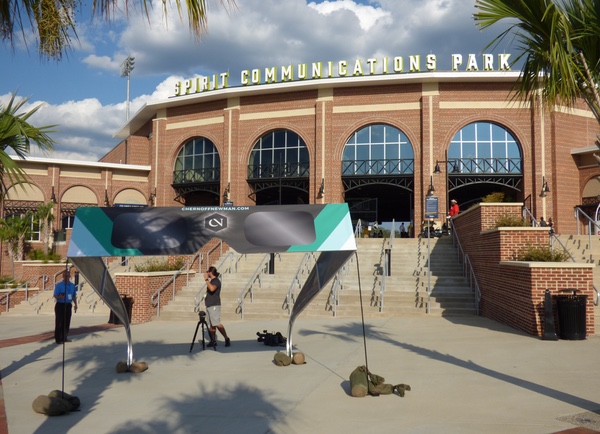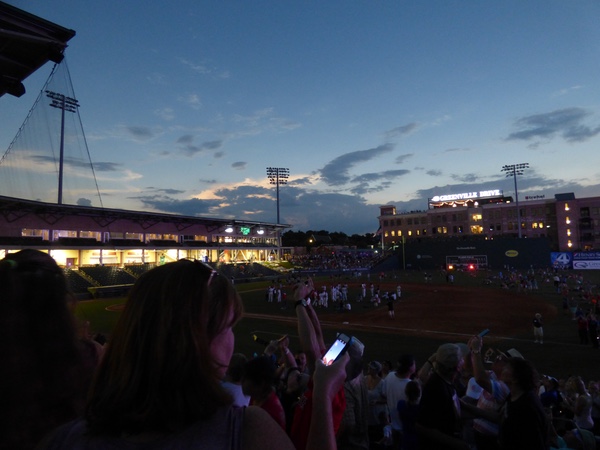
Working eclipse vacationby Jeff Foust
|
| Serious eclipse watchers—so-called eclipse chasers—had long ago made their travel plans. Available hotel rooms and campsites were booked far in advance of the eclipse. |
Weekday day games aren’t uncommon in baseball’s minor leagues, scheduled sometimes to accommodate travel for the home or visiting team, allowing them to get on the bus and make it to the next city before the middle of the night. Some are even scheduled in the late morning for visiting day campers.
Rarely, though, do they draw a sellout crowd. And in this case, the draw was not on the field—the finale of a four-game series between the visiting West Virginia Power and the home team, the Greenville Drive—but in the sky. The game started at 1:05 pm, shortly before the start of the eclipse that would soon darken the skies. If the weather held up.
What was widely known as the Great American Eclipse of 2017 could be seen across the United States, in a narrow band of totality that stretched from the Pacific coast in Oregon to the Atlantic coast in South Carolina. Millions of people lived in the path of totality, and millions more were expected to travel to the path to witness the eclipse (see “The science and spectacle of the Great American Eclipse”, The Space Review, February 6, 2017).
Serious eclipse watchers—so-called eclipse chasers—had long ago made their travel plans. Scrutinizing weather data and other factors, many had settled on a portion of the path from Oregon through Idaho into Wyoming to see the eclipse. The odds of clear weather were highest there: far enough inland to be free of coastal fog, but still early enough in the day that any clouds from afternoon storms would have yet to form. With the sparse population of that region, it meant that available hotel rooms and campsites were booked far in advance of the eclipse.
Those eclipse chasers, some motivated by science but others simply thrill-seeking a cosmic spectacle, likely turned up their noses to observing from South Carolina, like an oenophile offered a glass of Two-Buck Chuck. The eclipse would cross the state, from northwest to southeast, in the middle of the afternoon: peak time for the formation of afternoon storms. Moreover, given the time of year, there was always a chance a tropical storm or hurricane could eclipse the eclipse.
But, for those of us on the East Coast without the time, budget, or simply the advance planning to undertake a cross-country expedition to the intermountain West, South Carolina offered the best opportunity to see an eclipse on the cheap. So, with no professional duties for the eclipse—the web was already saturated with articles about eclipse planning, tips, and warnings to not stare at the sun without wearing special glasses—I planned a long weekend road trip to the Carolinas. Even if weather didn’t cooperate, I’d have the consolation prize of visiting some cities I had, at best, only driven through, and checking out their ballparks: mixing the Great American Eclipse with the great American pastime.
| On Saturday night, the team hosted “NASA Night,” which it primarily commemorated by putting a NASA theme to graphics on the scoreboard. |
The first stop on the trip was Columbia, South Carolina. It was one of several cities in the path of totality, from Salem, Oregon, to Charleston, South Carolina, that hosted minor league baseball teams that planned events around the eclipse. The Columbia Fireflies planned an entire weekend of events at its new ballpark, culminating with a “Total Eclipse of the Park” on Monday afternoon. During that game, the players would wear special themed jerseys with lettering designed to glow in the dark (as if people would be looking at the jerseys, and not the eclipse, during totality.) In front of the stadium was a giant pair of eclipse glasses.
On Saturday night, though, the team hosted “NASA Night,” which the team primarily commemorated by putting a NASA theme to graphics on the scoreboard. (The timing of the event coincided with the 71st birthday of former astronaut and NASA administrator Charles Bolden, a native of Columbia; a scoreboard message between innings wished him a happy birthday, but it wasn’t clear if he was actually in attendance.)
 A giant pair of eclipse glasses stands outside the ballpark in Columbia, South Carolina, during the weekend of the eclipse. (credit: J. Foust) |
Despite the expected crush of eclipse tourists, getting a hotel room in Columbia on Saturday night was not difficult a few weeks in advance of the event. Sunday night, though, was impossible: rooms were booked in hotels all along Interstate 26, which ran along the path of totality from near Greenville down to Charleston.
A short distance away, in Charlotte, North Carolina—outside the path of totality but within a couple hours’ drive—it wasn’t hard to get a room. Either there weren’t that many people taking long road trips to see the eclipse, or there would be a lot of daytrippers on Monday.
On Monday, I drove down Interstate 85 to Greenville, in traffic that was heavier than normal, but not gridlocked. Greenville, like Columbia, planned to play a game during the eclipse, including an “eclipse delay” during totality. The team hadn’t gone to the same lengths as Columbia to tie the game into the eclipse—no special jerseys, for example—but forecasts suggested slightly better chances of clear skies there.
Fluor Field at the West End, the ballpark near downtown Greenville, had taken on festive atmosphere that day. Long before the first pitch a little after 1 pm, people were streaming into the ballpark, serenaded by a soundtrack with predictable hits like “Total Eclipse of the Heart” and “Dark Side of the Moon.” Some scouted out the best spots on a small grassy berm in the left field corner, prime viewing for the eclipse. Others, whose seats were in the shade of the grandstand—normally highly desirable on a hot, humid day like this one—strategized where to stand when the eclipse took place.
As the game, and the eclipse, got underway, people were distracted from the game on the field by the spectacle in the skies. Between innings, and even during play, people turned around, donned their glasses, and looked up to check on the eclipse. Cries of “Wow!” and “Oh my God!” could be heard in the crowd, which had nothing to do with the progress of the game—Greenville soon fell behind 4-0—and everything with the progress of the Moon’s disk crossing the Sun. Even one of the coaches could be seen sneaking a view of the eclipse between innings, before stuffing his eclipse glasses in his back pocket as play resumed.
There was, though, the concern about the weather. The clear skies of Monday morning gave way to a scattering of cumulus clouds in the early afternoon. Would the clouds grow in coverage as the afternoon progressed? Or would one park itself between us and the Sun at a most inopportune time? Maybe those who ventured to Oregon and Idaho had the right idea all along.
One large cloud did move in front of the Sun in the early stages of the eclipse, blocking it for 10 to 15 minutes. Then it passed, as did another a little later that quickly passed by the Sun. But as totality approached, the clouds stayed away. Skies were clear where it counted.
About 15 minutes before totality, the game stopped for the prearranged eclipse delay. The team opened the outfield for those who wanted a clear view of the eclipse. Players from both teams sat down in the infield, leaning back to watch the eclipse. On the concourse, a meteorologist from a local TV station started doing live reports. It was nearly time.
As totality approached, I felt a sense more of relief than excitement. Skies were clear all around the Sun; there would be no clouds to disrupt the eclipse. Unlike the countdown for a launch, where there’s always the possibility of a last-second glitch triggering an abort, there was nothing stopping the celestial mechanics of this event. There was nothing to do but stand, watch, and enjoy.
| One can see it alone, in a park or a parking lot rather than a ballpark, but watching it with several thousand other people seemed to heighten the overall effect. |
And then totality arrived. The crowd gasped and cheered as darkness—really more of a deep twilight, enough to turn on lighted signs—descended on the ballpark. The free eclipse glasses (sponsored by Mountain Dew, oddly enough) handed out at the ballpark came off. A drone ascended to take in an aerial view.
Everyone has seen a picture of a total solar eclipse, the disk of the Sun turned into a black circle surrounded by a corona. Yet, even the high resolution photos of past eclipses paled in comparison to seeing it with the naked eye, taking in the twilight all around the horizon, and sharing the communal experience. One can see it alone, in a park or a parking lot rather than a ballpark, but watching it with several thousand other people seemed to heighten the overall effect.
 The crowd at Fluor Field in Greenville, South Carolina, takes in the solar eclipse during totality. (credit: J. Foust) |
And then it was over. Totality lasted for about two minutes in Greenville, which passed no quicker that I might have expected. The eclipse glasses came back on as the edge of the Sun emerged from behind the Moon. There were more cheers, as if to applaud the Sun and Moon for their cosmic performance.
Then it was back to normal, remarkably quickly. About 15 minutes after the eclipse ended, the game resumed. The eclipse might have helped the home team: down 4-0 at the time of the delay, they immediately scored six runs, going on to eventually win the game 8-7. It didn’t create any harmony between the teams, though: a hit batter triggered a benches clearing brawl later in the game.
A week later, the eclipse seems like a distant memory, overtaken by politics, natural disasters, and even the Game of Thrones season finale. Certainly, like the brawling ballplayers, it created no greater harmony. But, perhaps, it inspired a few people and created a greater curiosity about our place in the universe. That never hurts.
The end of the game brought an end to my working vacation. I had no regrets for taking a road trip version of an eclipse expedition, even during a long drive back home made longer by traffic that was stop-and-go almost all the way to Charlotte before finally clearing up. I’m not sure I’ll ever be the eclipse chaser that travels the world to glimpse a few minutes of totality: while exciting, that gets to be awfully expensive. But another solar eclipse is coming to the US in April 2024, from Texas to New England. I’m sure I’ll be up for another road trip then.